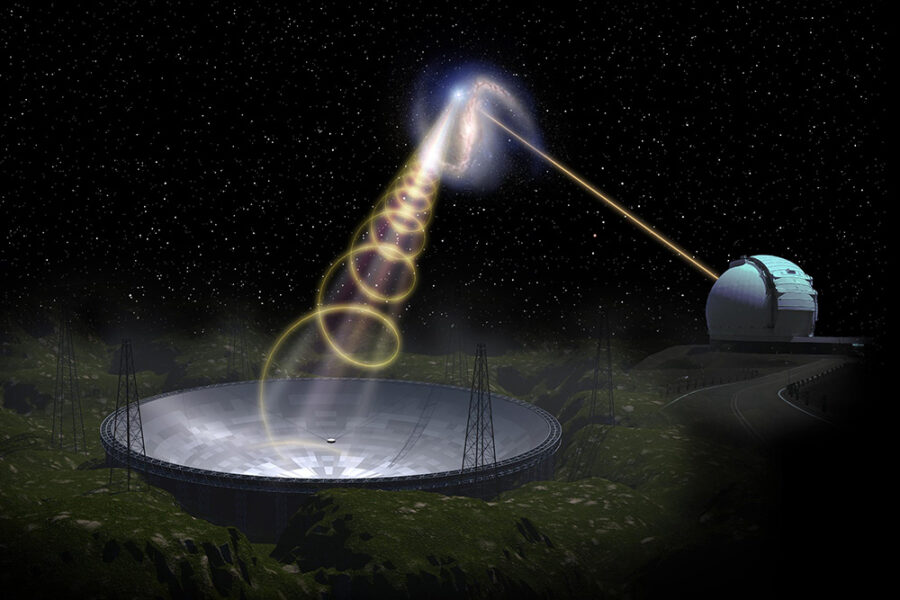A peculiar repeating fast radio burst seems to be coming from a dynamic environment in an otherwise uninteresting region, leaving researchers scratching their heads as to the burst’s origin.

Jingchuan Yu
Ever since their discovery 15 years ago, fast radio bursts (FRBs) have perplexed scientists. These short, ultra-bright flashes of radio energy happen all over the sky hundreds of times a day, visible from billions of light-years away.
But some flashes last milliseconds, others seconds, spanning a wide range of radio luminosities. Some only spark up once, while others repeat. And those that repeat can do it either erratically or in a regular way. What’s more, they appear to originate in a hodgepodge of different galaxies. Scientists are still struggling to make sense of the disparate data.
Until recently, there were dozens of ideas for what powers FRBs. But then in 2020, multiple bursts were detected coming from inside our own galaxy. Due to its proximity, astronomers were able to narrow down the source of the signal to a magnetar, a neutron star with a particularly strong magnetic field, known as SGR 1935+2154. Nowadays, many researchers think magnetars produce most FRBs, but it’s not settled just yet.
“Most FRB researchers I have met do favor a magnetar model, but I wouldn't say there's a consensus,” says Adam Lanman (McGill University, Canada). “There is still some debate about whether or not repeating and non-repeating FRBs come from the same source population.”

NASA’s Goddard Space Flight Center / Chris Smith / USRA / GESTAR
A recent study in Nature casts new light on this debate by providing a treasure trove of data for one specific repeating FRB: FRB 20201124A. Meanwhile, a separate theoretical study in Nature Communications posits that repeating burst’s most likely cause. However, the two don’t quite tally, leading to renewed questions about the nature of repeating FRBs.
Multiple bursts from FRB 20201124A were first detected by the Canadian Hydrogen Intensity Mapping Experiment (CHIME) in 2020. CHIME can scan vast regions of the sky and has captured a slew of FRBs, but it can’t interrogate each source in detail. This is why radio telescopes around the world with much higher magnification and smaller field of view trained their instruments on the area soon after the burst’s discovery.
Over several months in 2020, an international team amassed 91 hours of observing time monitoring FRB 20201124A on the world’s largest single-dish radio telescope, the Five-hundred-meter Aperture Spherical radio Telescope (FAST) in China. Detecting 1,863 bursts over 54 days, the haul represents the largest sample of bursts from one source that includes polarization data ever recorded.
The polarization data proved pivotal, because from it, the team could deduce the strength of the magnetic field and the density of the plasma near the FRB source. And the team was surprised to discover that either the magnetic field or the density near the FRB source are changing fast — within the timescale of a few days. “It suggests that it is definitely not something very simple – there is a dynamically evolving environment near the FRB source,” says team member Bing Zhang (University of Nevada).
To explain these strange results, four researchers proposed a sleek solution in Nature Communications (two of the team were also authors on the Nature paper as well). In their scenario, FRBs are generated in the region around a magnetar where the strong magnetic field dominates. But this magnetar has a companion: an extremely luminous blue star with a circumstellar disc of gas, known as a Be star.
From the magnetar’s violent supernova birth, it receives a kick, sending the orbital plane and disc plane into misalignment. This means that as the two stars dance around one another, radio bursts from the magnetar sometimes pass through different components of the Be star’s disc to reach the observer, creating the fast changes the FAST observers saw.
Astronomers have observed a similar scenario before in the binary system PSR B1259-63/LS 2883, which contains a pulsar and Be star. Moreover, some of the researchers had previously proposed that the properties of another repeating FRB — FRB 20180916B — could also come from a neutron star–Be star system.
“I think this is an excellent model that neatly explains the observed properties of the burst,” says Lanman. “But it's certainly not the end of the story!” For one, he adds, it’s interesting that while FRB 20201124A repeats, it doesn’t appear to do so regularly as would be expected from a binary system.
Amanda Weltman (University of Cape Town, South Africa) is also cautiously positive. “This seems to give us interesting clues about the magnetic field environment of this particular FRB source,” she says. “I cannot say it is the only explanation, [but it] points to future discovery paths, if this insight is correct.”
Although he is in favor of the idea of a binary source, even Zhang isn’t completely sold on the Be star/magnetar explanation either. That’s because of where the FRB source resides.
The team observed the FRB’s host galaxy using the 10-meter Keck telescopes located on Mauna Kea in Hawai‘i and discovered a metal-rich barred spiral galaxy like our Milky Way. “The FRB is in the outer arm region and also not near the core — it is in an intermediate location,” say Zhang. “That position is not particularly attractive for young stars.” And if there are few young stars there, then it’s unlikely the source is a young magnetar born from a supernova.
Zhang feels this result leads FRB researchers back to the drawing board, at least for this particular repeating FRB: “We need to really rethink everything. Start over,” he says.
The best way to make headway in solving this puzzle is to capture more data on FRB 20201124A and catch more repeating FRBs in the act. “The nature of FRBs is still up in the air, so to speak,” says Weltman. “And our best bet at solving the puzzles they present is through a multi-wavelength, multi-messenger, multi-national approach where we bring together the observations of many teams and telescopes to challenge our theories.”
 0
0









Comments
You must be logged in to post a comment.